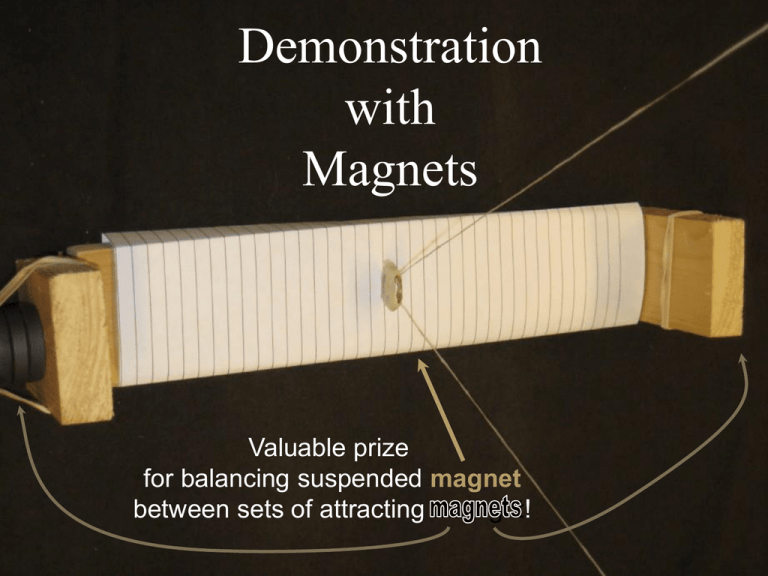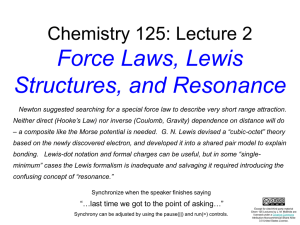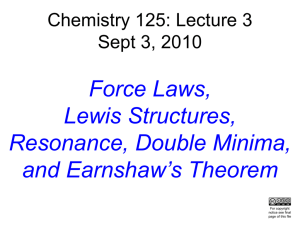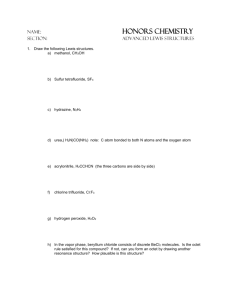
Demonstration
with
Magnets
Valuable prize
for balancing suspended magnet
between sets of attracting ma gnt!
Chemistry 125: Lecture 2
Sept 4, 2009
Force Laws,
Lewis Structures,
and Resonance
Congratulations to Saybrook!
(first to complete their directory on the Wiki)
For copyright
notice see final
page of this file
Are There Atoms
& Molecules?
What Force Holds
Atoms Together?
What Holds Atoms Together?
Hooks
Clips?
Friction?
Springs?
Bolts?
Hormones?
The Hands
of the Deity?
What Holds Atoms Together?
Gravity
Quarks
Electrical Forces
The Strong Force
Magnetic Forces
The Weak Force
Kinetic Energy
Strange Attractors
Quantum Forces
Exchange of Photons
Exchange of
Virtual Particles
Let’s Vote
Shared Electron Pairs
Robert
Boyle
P V = const
Air Pump built by his
servant Robt. Hooke
Robert Boyle
(1627-1691)
1661
1678
Hooke’s Law
Hooke’s Force Law
F = -k x
force
Scale
energy
extension
Hooke’s Law
“Ut tensio
sic vis”
Force x
Potential
2
x
Energy
Isaac Newton (1643-1727)
Force : Gravity
Attraction at a Distance
vs. Cartesian blocked repulsion
Newton :
Force r-2
(How about mass?)
Isaac Newton (1643-1727)
Query 31 in Opticks (1717)
Have not the small Particles of Bodies certain
Powers, Virtues, or Forces by which they act at a
distance, not only upon the Rays of Light for
reflecting, refracting and inflecting them, but also
upon one another for producing a great part of the
Phaenomena of Nature? For it's well know that
Bodies act one upon another by the Attractions of
Gravity, Magnetism and Electricity; and these
Instances shew the Tenor and Course of Nature,
and make it not improbable but that there may be
more attractive Powers than these. For Nature is
very consonant and conformable to her self.
Query 31
How these Attractions may be perform'd, I do not here consider. What I call Attraction may be perform'd by impulse,
or by some other means unknown to me. I use that Word here
to signify only in general any Force by which Bodies tend
towards one another, whatsoever be the Cause. For we must
learn from the Phaenomena of Nature what Bodies attract
one another, and what are the Laws and Properties of the
attraction, before we enquire the Cause by which the
Attraction is perform'd, The Attractions of Gravity, Magnetism and Electricity, react to very sensible distances, and so
have been observed by vulgar Eyes, and there may be others
which reach to so small distances as hitherto escape observation; and perhaps electrical Attraction may react to such
small distances, even without being excited by Friction.
Query 31
The Parts of all homogeneal hard Bodies which fully
touch one another, stick together very strongly. And for
explaining how this may be, some have invented hooked
Atoms, which is begging the Question; and others tell us
that Bodies are glued together by rest, that is, by an occult
Quality, or rather by nothing; and others that they stick
>2
together byMaybe
conspiringFMotions, that
is,
by
relative rest
1/r
chymical
amongst themselves. I had
rather infer from their
Cohesion, ?
that their Particles attract one another by some
Force, which in immediate Contact is exceeding strong, at
small distances performs the chymical Operations above
mention'd, and reaches not far from the Particles with any
sensible Effect.
Query 31
…the Attraction [between glass
plates separated by a thin film of Oil
of Oranges] may be proportionally
greater, and continue to increase
until the thickness do not exceed that
of a single Particle of the Oil.
Query 31
There are therefore Agents in Nature
able to make the Particles
of Bodies stick together by
very strong Attractions. And it is
the business of experimental
Philosophy to find them out.
(This business will take us nearly five weeks)
Fgravity =
mass1 mass2
2
r
Astronomy
Kepler, Newton
Felectrical =
charge1 charge2
2
r
(?)
Net Deflection (°)
Pointer Twist (°)
Meyzières Engineering School
Initially wanted to be a
1760-1761
mathematician
(1732-1799)
pith
ball
pp. 569-577
(0°)
gilded pith ball
Charles Augustin Coulomb
(1736-1806)
needle
deflection
scale
charge pinhead by rubbing
National Maritime Museum, Greenwich
Royal
ofpointer
Engineers
torsion
~1751Corps
“Charles
Augustin
with
deg. scale
continued1760-1790
to
deny
his mother’s
0 desire
36 that he study medicine
Académie
Royale des
Sciences
electrical
and
therefore
temporarily
126
18ofwas
in charge
building Ft. Bourbon, Martinique, 1764-1772
1793 funds, he
1781-1793
disowned.
Without
torsion
balance
silver wire
567 8.5
(~20join
m thick
was
forced to
his father in
1785
~1/4
of
a
hair)
Institut de France
Mémoires
de l’Académie
Montpellier.”
gilded
Royale des Sciences,
1795-1806
(Gillmour. 1971, p. 5)
data to derive his law for
repulsion of like charges:
F 1/r2
How certain could he be
that the exponent for r is
exactly 2, and not 2 + ?
That is, how large a could
be consistent with his data?
(Modern experiments, relevant to the
rest mass of the photon and to the
dimensionality of space, show < 10-17)
Hints: One approach would be to make
a plot based on numbers derived from
these data. You might want to consider
experimental error and geometry. Detail
on experiment and calculation is
available in the translation of Coulomb’s
paper on the course website.
0
Net Deflection (°)
(1) Coulomb used these
Pointer Twist (°)
Two Problems
36
126 18
567 8.5
(2) Two years later (1787)
Coulomb extended this law for
repulsion to include attraction
between opposite charges.
Explain why Coulomb would
need to develop a new
apparatus for this experiment.
That is, why couldn’t he just
use the same apparatus with
different charges on the two
gilded pith balls?
Hint: Remember that the torsional force is
approximately linear in the displacement.
It might help to graph the Coulombic and
torsional energies through a region that
includes the point where they balance.
Binding Energies from Various Sources
Coulombic q1q2/r : Proton-Electron at 1.54Å
(216 kcal/mol)
Magnetic 12/r3 : Electron Spins at 1.54Å
(0.0014 kcal/mol)
“Strong” Binding : Proton-Neutron in Deuterium Nucleus
(5 x 107 kcal/mol)
Gravitational m1m2/r : C atoms at 1.54Å
(3 x 10-32 kcal/mol)
Chemical Bond : C-C at 1.54Å
(90 kcal/mol)
(similar to 1 e Coulombic)
-3
0
3
6
(What of Kinetic Energy?) Log (Potential Energy) kcal/mol
Is there
a Chemical
Force Law?
How far can you Stretch
a Chain of Atoms
before it Snaps?
Demonstration
with
Magnets
Valuable prize
for balancing suspended magnet
between sets of attracting ma gnt!
Force Laws & Molecular Structure
Spring (ut tensio sic vis)
F = -k x
E = k/2 (x)2
nd Spring
=F
2Slope
(weaker,
opposing)
x minimum
Balanced
Single Minimum
Potential Energy
sum
0
0
Electrical Charges (gravity, etc.)
F = k / (x)2
E = -k/(2|x|)
sum
Balancedx minimum !
rd
3 Stronger
DoubleBody
Minimum
Thus with springs you might
make a stable polyatomic
molecule from point atoms.
(but not with ions or magnets)
However, if bonds obeyed
Hooke’s Law,
they could never break.
Morse Potential
Mathematically convenient approximation
for realistic bond energies
(proposed 1929)
Fixed
Neighbor
Sum
Second
Fixed
Neighbor
Morse Potential
Snaps at
Inflection Point
(Change from direct to inverse force)
What ARE bonds?
19th Century Experiments led to
VALENCE numbers
1861
Different # for different atoms: H(1), C(4), O(2), N(3)or 5?)
NH3 and NH4Cl
Why do Elements Differ?
Gertrude and Robert Robinson (1917)
Such slippery concepts “explain” so much
convinceScheme
you of nothing.
Why/Whenthat theyReaction
“latent”
valence
loop ?
Why/When
“partial dissociation”?
reaction
What does the
loop mean?
How Many?
Might Latent Valence Loop explain
trivalence of pentavalent N?
Might Partial Dissociation
explain amine/HCl reactivity?
product
Electron
Discovered
1897
The Cubic Octet
of G.N. Lewis
as as
Harvard
Harvard
Undergraduate
Instructor
~1894
~1902
© E. S. Lewis, by permission
(1875-1946)
Octet to "Explain" Periodicity & Electron Transfer
(1902 teaching notes)
Octet Predicts Shared Pair Bonding
shared edge
shared face
?
Cubic Octet to
to Tetrahedral
TetrahedralOctet
Octet
(G. N. Lewis 1916)
:N
N:
Tetrahedral distribution
of the bonds from C
had already been known
in organic chemistry
for 40 years!
Good Theory should be
Realistic & asSimple as possible
In regard to Facts
it should allow:
Prediction
Suggestion
Explanation
Classification
& Remembering
Postdiction:
Realm of Lore
End of Lecture 2
Sept 4, 2009
Copyright © J. M. McBride 2009. Some rights reserved. Except for cited third-party materials, and those used by visiting
speakers, all content is licensed under a Creative Commons License (Attribution-NonCommercial-ShareAlike 3.0).
Use of this content constitutes your acceptance of the noted license and the terms and conditions of use.
Materials from Wikimedia Commons are denoted by the symbol
.
Third party materials may be subject to additional intellectual property notices, information, or restrictions.
The following attribution may be used when reusing material that is not identified as third-party content:
J. M. McBride, Chem 125. License: Creative Commons BY-NC-SA 3.0
From Number of Valence Electrons
we would like to predict:
Constitution (valence numbers for different atoms)
Structure (distances & angles)
Charge Distribution
Energy Content
Reactivity
Lewis Explains Constitution
“the nature and sequence of bonds”
(Electron # Valence # and Unshared Pairs)
1
H
3
•
•
B•
•
Why Octet?
Why Pair for H / He?
•
4
3
•
••
C•
•
•
N
•
••
•
HN
H
••
H
••
••
•
2
••
O
••
1
•
•
••
F••
••
HCN
•
H C N
••
• •• ••
••
HC N
•
•
•
••
H C N•
••
•
•
•
•
Bookkeeping of Lewis had the idea
+
of using : to denote
“Formal” Charges unshared pairs.
NH3 H3N-BH3 BH3
(each atom is assigned
half-interest in bonding pairs)
••
H•
•
H • • N•
•
H
H
H
+ •• ••
•• • • •
•
•
•
H N• B• H
•
•
HH
Tetravalent N
is positive.
H•
•
B• • •H
•
H
Puzzle:
Tetravalent
B
2 BH
3 B2H6 + ~40 kcal/mol
What
is the “glue”? (Answer in Lecture 16)
is negative.
+ Surface Potential* of H3N-BH
3
(from Quantum-Mechanics)
HIGH
(+ 25 kcal/mole)
N end indeed bears
positive charge
and B end bears
negative charge
(-41 kcal/mole)
LOW
*) Energy of a proton on the “molecular surface”
Lewis Explains “Pentavalent” N.
Actually Tetravalent - thus Charged.
H+
H N H Cl
H
Amine Oxide
••
••
R• + • ••
R • • N• O
• ••
R
••
••
••
••
••
one
Sulfide
oxide
R• Peroxys
++2 • • • -• •
R • • S• • O
O
•• ••
O
••
Start Lewis-Drill Problems:
Draw Lewis Dot Structures for:
HNC
(in the order shown)
also for
HCNO
(CNO in all six linear orders, plus ring)
Start Memorizing
Functional Groups
EQUILIBRIUM vs. RESONANCE
:
:
+
N closer to C
all octets
H C N O
shift
to restore octet
shift
to eliminate charge sepn.
••
••
charge sepn
than to O
equilibrium
Geometric Implication?
all octets
• •- +
N ~midway
still charge sepn H C N O
••
between C and O
poorer site for -
••
Energy
••
but maybe
in truth…
left
N position
midway
Double
Minimum
EQUILIBRIUM vs. RESONANCE
+
H C N O
••
••
••
resonance
+
C N
O
••
••
H
-
••
single
compromise
position for N
Energy
Single
Minimum
left
N position
midway
Choice between
Resonance and Equilibrium
must be based on
experimental facts
(or a better theory)
that can distinguish single
from double minimum
Equilibrium vs. Resonance
A
B
Two Real Species
Compared to what?
A
B
One Real Species
Two “Reasonable”
Structural Formulas
Failure of
Simplistic Notation
Unusually Stable
Equilibrium vs. Resonance
H
H
C
O
••
•
•
• ••
•
••
O
H CC
H
••
••
O
O
••••
•
•
C
O
Two Species
LORE
• •
• •
••••
O
O
O
H
••
O
• ••
•
H
H C
C
One Species?
Species!
Two
One Nuclear Geometry!
••
••
••
••
O
•
•
(Evidence:
Infrared
Spectroscopy)
(Evidence:
Electron
Paramagnetic
Resonance)
H
What Holds Atoms Together?
Gravity
Quarks
Electrical Forces
The Strong Force
Magnetic Forces
The Weak Force
Kinetic Energy
Strange Attractors
Quantum Forces
Exchange of Photons
0
0
59 (unanimous)
10
5
20
7
12
3
Exchange of
Virtual Particles
5
Let’s Vote
Shared Electron Pairs
58
5







